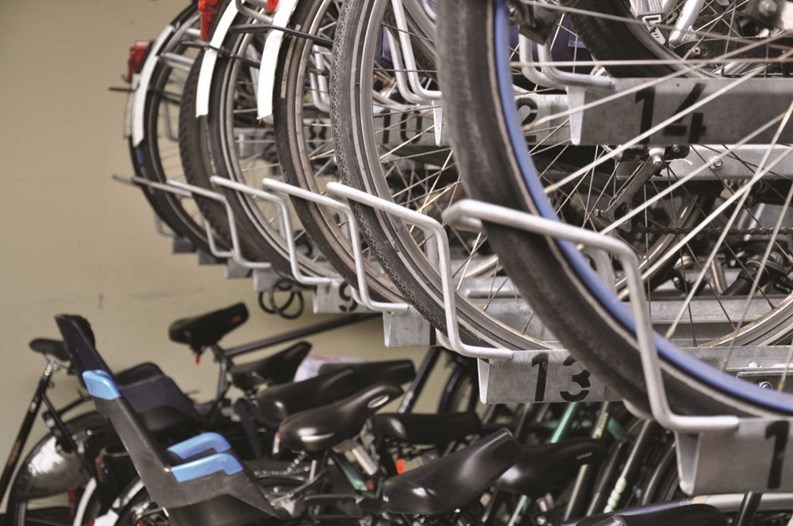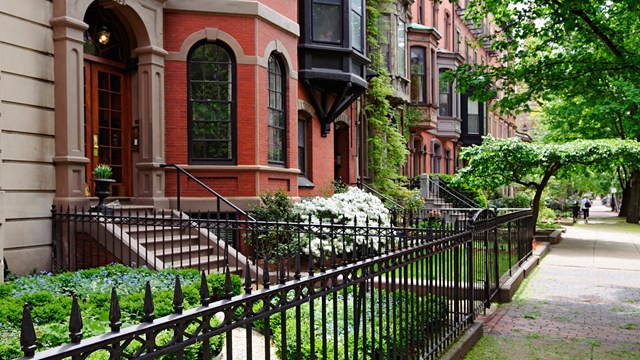As cities become more bike-friendly, and public consciousness about health and green living more predictable, condominium boards are debating questions about bicycle storage and safety around their properties.
This may not seem a complex subject, but it can become just as big a bone of contention as anything else for managers.
Consider, for instance, recent comments to a bicyclist’s blog query about storage; responses range from the practical to the whimsical:
• “Hang the front tire over the patio rail.”
• “One hundred percent ‘no’ to bike storage areas. You can just kiss your bike goodbye if you store it there.”
• “They’re at the foot of my bed … My bikes are the last thing I see when I go to bed and the first thing I see when I wake up.”
• “A big selling point for our apartment was the tile floors and cinder block walls. The walls are kinda ugly, but no bike is going to hurt them, and the dirt wipes off easy.”
• “Fill the tires with helium and let them float to the roof.”
A lot of opinions there, on a hot topic. Basically, bicycling is big in New England—especially during the prolonged warm seasons of late—and savvy condo developers are including riding paths and storage convenience among their benefits.
Boston, as one of the top-rated bike-friendly cities in the nation, has a focus on bicycle services at condominiums.
“Property will sell faster,” says Rob Cohen, CRS, ASR, ABR, realtor and president of Boston Distinctive Properties.”It’s beneficial to consider (storage) as part of the construction with new condos.”
Interest in bicycling facilities over the past decade, he says, has become huge around Boston, where there are thousands of students and two-wheeled commuters. “They’ve put in the bicycle rental areas, similar to a Zipcar. Along Boylston Street, and other parts of the city, you can pick out a bike, sign it out, return it later. Also, bike lanes have been installed along Commonwealth Avenue and other parts of Boston, so it’s absolutely an important part of living in the city—an extremely important part.” The rental service is expanding rapidly.
Those who own bicycles need to house them securely. Even high-end condo users have storage concerns.
Selling Point
“In the Back Bay, Beacon Hill, the South End, new developments on the waterfront, 65 to 75 percent of people looking for a condo normally ask if there is somewhere to store a bicycle,” Cohen says.
That’s an impressive figure. While people who are really interested in a property will generally find another way to store their bikes when storage is not adequately provided, Cohen says, it’s a significant consideration for them. Some will reject a location on that basis. “It’s important to have somewhere to store items like baby carriages (also important in Boston) or a bicycle.”
One example of bike-friendly Boston is at Wilkes Passage, a seven-story South End condo with 159 loft-style units. Not only is there 24-hour security, there is an underground parking area with bike storage.
As one moves toward more urban high-rises, “underground” becomes a frequent option to locked rooms or in-unit storage.
Basically, talking bicyclists and condos, means talking about regulations for security, aesthetics and safety, especially at older buildings transformed into condominium dwellings. All boards have to consider inside storage setups, building traffic, and liability.
Although condo marketing strategies these days tout bicycle paths to entice buyers, the rules and regulations don’t always cater to them. Older, more established communities may need to modify rules (and storage areas). The rules may allow bike storage in hallways or movement via elevator, both of which give rise to complaints—as any board can attest. In contrast, prohibiting elevator use for bikes is tough on someone living up 16 flights of stairs.
Security is Key
Loss or damage is the bike operator’s own risk, but storage facilities should be responsive.
“Most buildings allow owners to store bikes in their units if they cannot provide a secure area to keep them locked,” says Nicholas Boit, president of Barrington Management Co. in Arlington, Massachusetts. “There is no liability to the association if a bike is stolen. It is at the sole risk of the owner to store in a common area, or even in a designated storage area.”
In other words, say several sources, bikes must be insured under homeowner policies, and residents must be so informed.
“Hopefully, an association would put in place rules and regulations, and give notice to unit owners that they have to take responsibility for maintaining their own security,” says attorney Diane Rubin, a partner at Prince Lobel Tye LLP in Boston. “They need to enact some rules, try to make sure there’s clarity that (damage or theft) is a unit owner’s responsibility, so they don’t get pegged with something like that.”
Even when there are specific storage areas, some owners refuse to use them, not wanting to leave a bike worth several thousand dollars where it can be stolen or damaged.
“In a couple of buildings, there has been some traditional area that’s been used for bike storage, and there are now too many bikes for the amount of room space. It may have been set up for 20 or 25 bikes, but now there are 40 people wanting to use it,” says Rubin.
Over the decade, she says, associations have put more resources into the space problem “to try to find a system, stacking or tiered storage for instance, that will accommodate growth.”
Residents have complained about bike racks and improperly stored bicycles. “They can get messy if they’re not maintained well,” Rubin says. There is also disagreement about transporting bikes from the street to a resident’s unit by using the elevator. “They take up a lot of space, bump into things,” she says. Nothing has risen to the level of a lawsuit, but there is “grumbling.”
It’s in the Law
In Cambridge, adjacent to Boston, bicycling is not just encouraged, it’s protected. Viewing bike traffic as an economical, healthful and green mode of transport, the city has done its best to ensure bicyclists are fairly provided for. In all new development and redevelopment projects, bike parking must be provided in accordance with zoning requirements. Locations and layouts must be included in building site plans, and approved by the regulatory parties. Additionally, multifamily residences must provide at least one bicycle parking space or locker for every two residences. The city further stipulates both size and shape of bike racks, and where they should be located.
In other words, it’s the law.
That’s not the case everywhere. But there is progress. In May, the League of American Bicyclists named Massachusetts the third most bike-friendly state in the country.
“Each complex is different, so they all handle bike storage in a different way,” says Nick Ruccolo, CPM, PCAM, CMCA, a vice president at Crowninshield Management, which oversees more than 5,000 units.
He breaks management issues up by development size:
Townhouses—Easiest to deal with, are typically two-unit residences with fairly simple storage situations. “They all just place the bike in the back areas, typically a deck area, or bring it inside. Townhouses with garages have very few issues,” he says.
Garden-style—“These units pose a little bit of a problem, because there’s minimal storage inside (many are converted apartment buildings), and now you need a bike rack outside, and some people won’t leave a very expensive bike on a bike rack.” He cites one person with an $8,000 bicycle. “Then it becomes a matter of storage inside,” says Ruccolo. “Many (facilities) have made such arrangements, but some don’t, and you’ll see them under stairwells, and other places that are inappropriate.” That’s when storage starts to become an aesthetic or safety issue among neighbors.
Mid- and high-rise condominiums—“These typically come with separate storage areas,” Ruccolo says. “You try to make common area storage for them, or they use their own units.” Frequently, riders dislike locked storage areas as inconvenient—but it’s still a good option, he says. “One condo building in Cambridge provides a locked bicycle room with keypad entry, and none of the bikes (inside) is even locked. Residents feel safe enough—and these are very expensive bikes.”
But theft motivates some to take their bikes inside. There is an interesting conversation about the topic at roadbikereview.com, where members comment about methods of storing bikes in confined interiors. Complete with pictures (which some might find preposterous and others will love), the blog looks at wall racks, folding bikes, etc., for resolving storage problems. In one, an attractive, multi-paned wall of windows has been framed—not with curtains but with dual bike racks.
When it comes to common areas, management has to define what’s acceptable—and not—when it comes to bicycle storage. It’s a challenge that seems to be growing with each passing year, as the interest in green travel blossoms.
Ann Frantz is a freelance writer and a frequent contributor to New England Condominium.






Leave a Comment